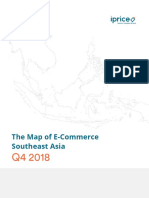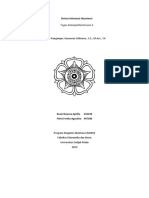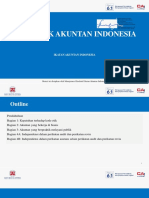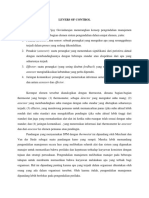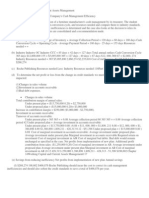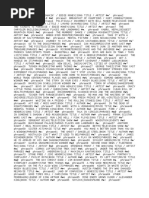Unilever, Leader in Social Responsibility: E-135: Corporate Sustainability Strategy
Unilever, Leader in Social Responsibility: E-135: Corporate Sustainability Strategy
Uploaded by
Victor TorresCopyright:
Available Formats
Unilever, Leader in Social Responsibility: E-135: Corporate Sustainability Strategy
Unilever, Leader in Social Responsibility: E-135: Corporate Sustainability Strategy
Uploaded by
Victor TorresOriginal Description:
Original Title
Copyright
Available Formats
Share this document
Did you find this document useful?
Is this content inappropriate?
Copyright:
Available Formats
Unilever, Leader in Social Responsibility: E-135: Corporate Sustainability Strategy
Unilever, Leader in Social Responsibility: E-135: Corporate Sustainability Strategy
Uploaded by
Victor TorresCopyright:
Available Formats
E-135: Corporate Sustainability Strategy
Unilever, Leader in Social Responsibility
(Case for Week 7, Oct. 10-16, 2016)
Unilever’s history dates back to the 1890s, when William Hesketh Lever, founder of Lever
Bros company, stated his vision for Sunlight Soap – a product he hoped would
revolutionize Victorian England and bring about a new era of cleanliness and hygiene.
He hoped “to make cleanliness commonplace; to lessen work for women; to foster
health and contribute to personal attractiveness, that life may be more enjoyable and
rewarding for the people who use our products” (Unilever, 2016a).
Today, Unilever’s more than 400 brands are used by over 2 billion people on any given
day, according to the company’s website. Their portfolio of products includes Vaseline,
Lifebuoy, Lipton, Dove, Hellman’s, Suave, Ponds, and even Ben & Jerry’s (Unilever,
2016b).
Yes, it was Unilever who bought Ben & Jerry’s in 2000, when it also acquired SlimFast. It
was a match made for commentary. Both were closely held companies at the time,
and even though SlimFast was the much larger company, the acquisition of Ben &
Jerry’s was the one that created a stir, at least in the environmental community. But
even though the purchase brought Ben & Jerry’s under the umbrella of Unilever,
agreements were made that conserved some of the original vision of Ben & Jerry’s
founders. These included purchasing milk from Vermont dairy farmers at a higher than
market rate, and donating 7.5% of the ice cream company’s pretax profit to charity
(Branch & Beck, 2000).
Unilever is one of the most highly respected companies in the world today, listed at the
top by far in the GlobeSpan and SustainAbility survey from 2015 (GlobeScan &
SustainAbility, 2015). It is recognized for its leadership in sustainability and its ethical
behavior. William Lever’s original vision has been expanded, and its corporate purpose
now states that the company’s success requires "the highest standards of corporate
behaviour towards everyone we work with, the communities we touch, and the
environment on which we have an impact" (Unilever, 2016c).
How has Unilever achieved this success? What management tools and systems has it
used to facilitate its rise? What organizations and companies has it partnered with to
embed its systems throughout its supply chain? How has it made a business case for its
investments in local communities and environmental resources? How has it improved its
stakeholder engagement? These are some of the questions we will investigate this week
as you delve into Unilever’s various engagements around the world.
And there is good news for you! Unilever has published extensive information on its
website regarding sustainability. There are two smaller overviews of their sustainability
plan available for download, and the rest of their information is linked throughout their
website. Their GRI reporting section has a link to a downloadable PDF, Unilever’s GRI
Index, that contains links to various areas on the website or other documents dealing
Suzanne Farver, 2016
E-135: Corporate Sustainability Strategy
with specific topics. This helps the reader get right to the section they are interested in,
and also provides an overview of the reporting topics (Unilever, 2016d).
This is relatively new trend in sustainability reporting, allowing the reader to quickly drill
down to particular areas of interest rather than having to “thumb” through pages of a
sustainability report PDF searching for the topic. You will have an opportunity to
compare this method of GRI reporting this week versus the more formal sustainability
report compiled by Alcoa last week. Which do you prefer? Advantages of the online
system allows for constant updating, but are there also advantages to having
everything in one document? It will be interesting to see how companies continue to
enhance their reporting and search for the right solution for their particular group of
stakeholders.
Unilever’s Sustainable Living Plan aims to “decouple” its growth from its environmental
impacts while increasing its positive affects upon society. They speak of facing the
challenges of climate change while still providing for human development, striving to
help people live comfortably while staying within the limits of the natural world, and
making sustainable living “commonplace.” To achieve this, they have developed
strategies to integrate sustainability into their products and their supply chain. They
have made public commitments to integrity and good governance, and they are
reporting on their progress in regular intervals (Unilever, 2016d).
However, they have not achieved all of their goals. Just as other multinational
companies struggle with labor issues in their supply chain so has Unilever. We saw in the
week on stakeholder engagement how Levi Strauss worked with local NGOs and
companies to help resolve its supplier issues. Unilever has also engaged with other
organizations, and a 2013 report by Oxfam (Wilshaw, Unger, Chi, & Thuy) explains the
some of the issues and challenges in depth regarding labor issues in Vietnam.
Despite codes of conduct and policies prescribed from the top management and
audits in the field, problems persist. Oxfam found that the local managers lacked the
knowledge and capacity to ensure that the guidelines specified by the company were
followed, and Unilever’s goals for fair treatment were not met. For example, workers in
supplier factories were found to be hired on a temporary basis to avoid the minimum
requirements set by Unilever, and overtime hours were well beyond the legal limits.
Keeping workers on a temporary basis avoided the right to collective bargaining and
other benefits.
Unilever partnered with Oxfam on this report, and it is a testament to their commitment
to improvement that such transparency was present. Indeed, Unilever’s VP HR of Global
Supply Chain recognized the importance of employee welfare when he stated,
“Unilever’s analysis shows that where there are good conditions and empowerment of
employees, the factory has the best results.” (Wilshaw, Unger, Chi, & Thuy, 2013, p. 14).
The Oxfam report contains recommendations for proactive stakeholder engagement
and management priorities to achieve these goals, as well as a commitment from
Unilever to study the problem in depth and implement appropriate procedures to
achieve fair working conditions throughout the supply chain.
Suzanne Farver, 2016 2
E-135: Corporate Sustainability Strategy
The current information from Unilever recognizes the continuing challenges of labor
rights in countries where laws and governments are not as protective as they are in
developed countries. For issues such as child labor, they are working toward
incentivizing their suppliers to do better, rather than emphasizing compliance. They are
working toward building capacity for their suppliers and promoting and rewarding best
practices to encourage more suppliers to perform better rather than competing with
one another for low prices (Unilever, 2016e). This sounds very similar to what we saw with
Levi Strauss’s approach.
An updated publication from Oxfam in 2016 reports significant progress from Unilever on
many of the labor issues recognized in 2013, but many challenges remain. In particular,
they made progress in Vietnam, increasing trust between workers and managers, and
improving the grievance procedures. Suppliers are also more aware of expectations,
and excessive labor hours have been reduced. However, there are still some key
unresolved issues that were addressed in the report: convincing more suppliers of the
business case for fair labor treatment; ensuring fair compensation across the board and
empowering women; and addressing systemic issues of child labor, slavery and gender-
based violence – issues in the supply chain that affect others besides Unilever (Wilshaw,
Unger, Chi, & Thuy, 2016). This is a very tough problem, as you have begun to see, and
you will be able to address it from another perspective this week through the lens of
Unilever.
We have provided links to various Unilever webpages on this week’s page, and also
given you a link to the two Oxfam reports. This should give you a start on examining
Unilever’s activities. You should have an interesting week learning about this company
and how it impacts the world’s social systems.
References
Branch, S., & Beck, E. (2000). Unilever buys Ben & Jerry’s, SlimFast for Over $2.5 billion. The
Wall Street Journal. Retrieved from:
http://online.wsj.com/news/articles/SB955522850788928066
GlobeScan & SustainAbility. (2015). The 2015 sustainability leaders; A
GlobeScan/SustainAbility survey. Retrieved from:
http://www.globescan.com/component/edocman/?view=document&id=179&Itemi
d=591
Unilever. (2016a). Who we are: Our history. Retrieved October 1, 2016 from:
http://www.unilever.com/aboutus/ourhistory/
Unilever. (2016b). Who we are: About Unilever. Retrieved October 1, 2016 from:
https://www.unilever.com/about/who-we-are/about-Unilever/
Unilever. (2016c). Who we are: Purpose, value and principles. Retrieved October 1, 2016
from: https://www.unilever.com/about/who-we-are/purpose-and-principles/
Unilever. (2016d). Introducing our plan. Retrieved October 2, 2016 from:
https://www.unilever.com/sustainable-living/the-sustainable-living-plan/
Unilever. (2016e). Fairness in the workplace. Retrieved October 2, 2016 from:
https://www.unilever.com/sustainable-living/the-sustainable-living-plan/enhancing-
livelihoods/fairness-in-the-workplace/
Wilshaw, R., Unger, L., Chi, D. Q., & Thuy, P. T. (2013). Labour rights in Unilever’s supply chain:
From compliance towards good practice; An Oxfam study of Unilever’s Vietnam
Suzanne Farver, 2016 3
E-135: Corporate Sustainability Strategy
operations and supply chain. Oxfam. Retrieved from:
http://www.unilever.com/images/rr-unilever-supply-chain-labour-rights-vietnam-
310113-en_tcm13-355788.pdf
Wilshaw, R., Unger, L., Chi, D. Q., & Thuy, P. T. (2016). Labour rights in Vietnam: Unilever’s
progress and systemic challenges. Oxfam. Retrieved from:
https://www.oxfam.org/sites/www.oxfam.org/files/file_attachments/rr-unilever-
vietnam-progress-challenges-040716-en.pdf
Questions for this week:
NOTE: Remember that this is a virtual exercise. No contact should be made with any of the
case companies you are investigating.
1. Social Responsibility Thread: Why has Unilever been recognized as a leader in social
responsibility? What types of issues stand out from the perspective of the readings on
social responsibility we have provided this week? How are they improving their
performance? Who are their most important stakeholders, and how are they
engaging them in this effort? What are some of the challenges they are facing – are
they transparent about these challenges or do you have to find out about them
elsewhere? Can you find the business case for their efforts in improving social
impacts?
2. Sustainability Living Plan Thread: Take a look at Unilever’s Sustainability Living Plan.
What are the most material issues from a social responsibility perspective, and how
have they selected them? How does improving their performance in these areas
affect their performance overall? Are they cooperating with other organizations or
companies to learn about best practices, or are they the leaders in most cases? Are
there differences in various brands or regions, or are there universal tools and
guidelines used throughout the company?
3. Oxfam Thread: Take a look at the Oxfam reports mentioned in this case. What tools
and methods does Oxfam recommend to Unilever to improve the labor conditions in
its factories in Viet Nam? Looking at the second Oxfam report, what kinds of progress
has Unilever made, and how did it accomplish that? What do you think are the
toughest challenges, and how might those be resolved? Can you find similarities or
contrasts with the Levi Strauss stakeholder engagement on this issue?
4. Standards and Performance Thread: The Oxfam reports also mention international
standards and the need for better governance in the countries where Unilever and
other major companies operate. How is Unilever using these standards to address
the labor challenges it faces in Southeast Asia? Does this help to distinguish Unilever
among its peers? How does their strategy and implementation compare with other
multinational companies in a similar industry, such as Proctor & Gamble or L’Oreal?
How does it compare with companies such as Levi Strauss or Alcoa? For graduate
students, how does it compare with your own case company for your final paper?
Suzanne Farver, 2016 4
You might also like
- Nutratask Inc Is A Pharmaceutical Manufacturer of Amino Acid Chelated Minerals andDocument3 pagesNutratask Inc Is A Pharmaceutical Manufacturer of Amino Acid Chelated Minerals andAmit PandeyNo ratings yet
- ERP Helps Productivity at Northern Digital IncDocument10 pagesERP Helps Productivity at Northern Digital IncImeldaNo ratings yet
- BUS - 6100 - Milestone 1Document8 pagesBUS - 6100 - Milestone 1Hafsat SaliuNo ratings yet
- (Group 7) Case 5 - Thieves in TexasDocument13 pages(Group 7) Case 5 - Thieves in TexasPintonov PutraNo ratings yet
- Case 2 Nothern DigitalDocument2 pagesCase 2 Nothern Digitalzzz202xNo ratings yet
- ERP Helps Productivity at Northern Digital IncDocument10 pagesERP Helps Productivity at Northern Digital IncLihin100% (1)
- Corporate DisclosureDocument46 pagesCorporate DisclosureSameerLalakiyaNo ratings yet
- BMDE Group 8 Sec F Assignment 1 PDFDocument9 pagesBMDE Group 8 Sec F Assignment 1 PDFKeshavNo ratings yet
- Case Study - Financial ServiceDocument5 pagesCase Study - Financial ServiceNia ニア Mulyaningsih0% (1)
- Case 8.3 Emerson (Editted)Document3 pagesCase 8.3 Emerson (Editted)AmirQayyum100% (1)
- Bad Food and Good Physics The Development of Domestic Microwave CookeryDocument10 pagesBad Food and Good Physics The Development of Domestic Microwave CookeryutkwuNo ratings yet
- Cerebrosoft DecisiontreeDocument4 pagesCerebrosoft Decisiontreemeetmukesh0% (1)
- Sustainability 12 06136Document13 pagesSustainability 12 06136Sagitarius SagitariaNo ratings yet
- Group-03: SIEMENS: Building A Structure To Drive Performance and ResponsibilityDocument6 pagesGroup-03: SIEMENS: Building A Structure To Drive Performance and ResponsibilityRohit KaliaNo ratings yet
- Nokia Strategy PresentationDocument141 pagesNokia Strategy PresentationMuraliNo ratings yet
- Siemens Team5Document8 pagesSiemens Team5nevin04No ratings yet
- Solutions/solution Manual15Document50 pagesSolutions/solution Manual15Bea BlancoNo ratings yet
- (Excel) Wilbur TinaACC650 T3Document1 page(Excel) Wilbur TinaACC650 T3Tina Marie WilburNo ratings yet
- ISA 240: The Auditor's Responsibilities Related To Fraud in An Audit of Financial StatementsDocument25 pagesISA 240: The Auditor's Responsibilities Related To Fraud in An Audit of Financial StatementsIndriNo ratings yet
- Kasus MillerDocument3 pagesKasus MillerFirman NurzamanNo ratings yet
- Digital Microscopy at Carl ZeissDocument1 pageDigital Microscopy at Carl ZeissPrathamesh DalviNo ratings yet
- 10 - 11 - 12 - Data Cruncher Plus InstructionDocument6 pages10 - 11 - 12 - Data Cruncher Plus InstructionatikasaNo ratings yet
- Aurora PaperDocument6 pagesAurora PaperZhijian Huang100% (1)
- Testing and Evaluation of SystemsDocument24 pagesTesting and Evaluation of SystemsAnnaNo ratings yet
- Case 2 S 1 Apple The Iphone Turns 10 PDFDocument20 pagesCase 2 S 1 Apple The Iphone Turns 10 PDFMifta ZanariaNo ratings yet
- Erm Appendix CDocument4 pagesErm Appendix CNatasha ChairaNo ratings yet
- Case 1: Anna'S Business IdeaDocument1 pageCase 1: Anna'S Business IdeaDivantri FaadhilahNo ratings yet
- The Map of E-Commerce South East Asia - Q4 2018Document5 pagesThe Map of E-Commerce South East Asia - Q4 2018Aryu NutsNo ratings yet
- Management Keuangan Lanjutan - Arcadian Microarray TechnologiesDocument14 pagesManagement Keuangan Lanjutan - Arcadian Microarray Technologiesgrace laurensiaNo ratings yet
- 15 Ways To Improve Your Focus and Concentration SkillsDocument1 page15 Ways To Improve Your Focus and Concentration Skillsfrostghost0714No ratings yet
- Jawaban Case B TexasDocument7 pagesJawaban Case B TexasGilangRamadhanNo ratings yet
- Optimum Capital StructureDocument7 pagesOptimum Capital StructureOwenNo ratings yet
- Satya NadellaDocument8 pagesSatya Nadellaincompletetask25No ratings yet
- IKEA Case StudyDocument3 pagesIKEA Case StudyvivanNo ratings yet
- 2009-01-06 043437 GoodDocument3 pages2009-01-06 043437 GoodAlthea LandichoNo ratings yet
- Ganesha Syndicate Harris Desfianto - 29113006 Harry Harsa - 29113083 Fadhly - 29113130Document3 pagesGanesha Syndicate Harris Desfianto - 29113006 Harry Harsa - 29113083 Fadhly - 29113130Harry Harsa Bani PartaprajaNo ratings yet
- Case SPMDocument4 pagesCase SPMainiNo ratings yet
- Laporan MagangDocument41 pagesLaporan MagangMuhammad IqbalNo ratings yet
- Tugas 4Document7 pagesTugas 4Fitria Fertha AgustinaNo ratings yet
- Analisis Prediksi Potensi Resiko Fraudulent Financial Statement Melalui Fraud Score ModelDocument14 pagesAnalisis Prediksi Potensi Resiko Fraudulent Financial Statement Melalui Fraud Score ModelZhafirah Nabilah SaryNo ratings yet
- Apple Inc.: Corporate Level Strategy and Strategic Alternatives and Recommend StrategyDocument10 pagesApple Inc.: Corporate Level Strategy and Strategic Alternatives and Recommend StrategyTricia VistaNo ratings yet
- Apple PESTLE AnalysisDocument7 pagesApple PESTLE Analysiswaleed AfzaalNo ratings yet
- P&G AnalysisDocument21 pagesP&G AnalysisThảo PhanNo ratings yet
- The Coca-Cola Fiasco 1Document3 pagesThe Coca-Cola Fiasco 1Aadya MadanNo ratings yet
- Case Study: Colombo Frozen YogurtDocument3 pagesCase Study: Colombo Frozen YogurtandresuminhNo ratings yet
- Emerson Electric Co.Document3 pagesEmerson Electric Co.Silver BulletNo ratings yet
- Internal ControlDocument105 pagesInternal ControljnfebrinaNo ratings yet
- Finanacial Statements: Balance Sheet & Profit and Loss AccountDocument26 pagesFinanacial Statements: Balance Sheet & Profit and Loss AccountAshok SeerviNo ratings yet
- Customer and Product Profitability at BanksDocument15 pagesCustomer and Product Profitability at Banksmuhaayan87100% (1)
- Kelompok 1 - Case StarbucksDocument17 pagesKelompok 1 - Case StarbucksMarco SimoncelliNo ratings yet
- Kode Etik Akuntan Indonesia - SDWDocument122 pagesKode Etik Akuntan Indonesia - SDWDiah Ayu YunitasariNo ratings yet
- Levers of Control: Assessor Mengindikasikan Kebutuhan Yang Perlu DipenuhiDocument5 pagesLevers of Control: Assessor Mengindikasikan Kebutuhan Yang Perlu DipenuhiciciNo ratings yet
- COSO Implementasi Dan DesainDocument8 pagesCOSO Implementasi Dan DesainWito AjaNo ratings yet
- 7-Eleven in TaiwanDocument14 pages7-Eleven in TaiwanmmcNo ratings yet
- International Equity Placement Strategic Alliances: Case at IndosatDocument26 pagesInternational Equity Placement Strategic Alliances: Case at IndosatFez Research Laboratory100% (1)
- Chapter 5 Net Present Value and Other Investment RulesDocument43 pagesChapter 5 Net Present Value and Other Investment RulesNurul Meutia SalsabilaNo ratings yet
- UVA Health System - LTAC Hospital Case GuidanceDocument2 pagesUVA Health System - LTAC Hospital Case GuidanceLana AlghamdiNo ratings yet
- Kemenkeu - BCA - Indonesia Macroeconomic Update - Drawing A Silver Lining On Post-Covid 19 EraDocument26 pagesKemenkeu - BCA - Indonesia Macroeconomic Update - Drawing A Silver Lining On Post-Covid 19 EraAryttNo ratings yet
- 13.report WritingDocument14 pages13.report WritingSidharth BhardwajNo ratings yet
- Chapter 14working Capital and Current Assets ManagementDocument1 pageChapter 14working Capital and Current Assets ManagementMaricris RellinNo ratings yet
- Hertz Goes Wireless PG 252Document8 pagesHertz Goes Wireless PG 252Manisha PuriNo ratings yet
- ASEAN Corporate Governance Scorecard Country Reports and Assessments 2019From EverandASEAN Corporate Governance Scorecard Country Reports and Assessments 2019No ratings yet
- Operational Risk Management A Complete Guide - 2021 EditionFrom EverandOperational Risk Management A Complete Guide - 2021 EditionNo ratings yet
- Environment Case Alcoa 2016Document4 pagesEnvironment Case Alcoa 2016Victor TorresNo ratings yet
- Guide Dissertations DefenseDocument2 pagesGuide Dissertations DefenseVictor TorresNo ratings yet
- Economic Responsibility and IKEA: E-135: Corporate Sustainability StrategyDocument5 pagesEconomic Responsibility and IKEA: E-135: Corporate Sustainability StrategyVictor TorresNo ratings yet
- E-135: Corporate Sustainability Strategy: BMW and SmsDocument5 pagesE-135: Corporate Sustainability Strategy: BMW and SmsVictor TorresNo ratings yet
- Case Supply Chain 2016 AdidasDocument5 pagesCase Supply Chain 2016 AdidasVictor TorresNo ratings yet
- Sustainability Metrics: Considering Materiality at Marks & SpencerDocument10 pagesSustainability Metrics: Considering Materiality at Marks & SpencerVictor TorresNo ratings yet
- Worksheet PDFDocument1 pageWorksheet PDFVictor TorresNo ratings yet
- Violencia Historia PDFDocument26 pagesViolencia Historia PDFVictor TorresNo ratings yet
- HTML Tags ChartDocument7 pagesHTML Tags Chartavnika soganiNo ratings yet
- Hangaroo ProjDocument54 pagesHangaroo ProjQazi Waheed Gul100% (2)
- Bidding DocumentsDocument118 pagesBidding DocumentsMuhammad shahzaibNo ratings yet
- The Mystery Method - Opening TipsDocument3 pagesThe Mystery Method - Opening TipsJoseph100% (1)
- Rule of Three Studios v. Drew BarrymoreDocument9 pagesRule of Three Studios v. Drew BarrymoreTHROnlineNo ratings yet
- Solomon's TempleDocument8 pagesSolomon's TempleJames ClarkNo ratings yet
- Anesthesia MonitoringDocument26 pagesAnesthesia MonitoringBritten Norman SantiagoNo ratings yet
- Kami Export - Serenity Richards - Forces & Newton's LawsDocument13 pagesKami Export - Serenity Richards - Forces & Newton's LawssrdelightNo ratings yet
- Bill Adams (Georgia Power) PDFDocument25 pagesBill Adams (Georgia Power) PDFAkinbode Sunday OluwagbengaNo ratings yet
- ODI 4 Test Unit 5-6Document2 pagesODI 4 Test Unit 5-6SilvanaNo ratings yet
- FPT-Software_Data-EngineerDocument2 pagesFPT-Software_Data-EngineerTự NguyễnNo ratings yet
- Personal Protective Equipment and First Aid: ObjectivesDocument31 pagesPersonal Protective Equipment and First Aid: Objectiveslakshmiramar180No ratings yet
- 4-Ps-of-Marketing AgEconDocument60 pages4-Ps-of-Marketing AgEconJohn Paul CabangalNo ratings yet
- Year 9 Topic 1 ScienceDocument24 pagesYear 9 Topic 1 SciencetheyomangamingNo ratings yet
- Chang v. Winklevoss ComplaintDocument33 pagesChang v. Winklevoss Complaintgesmer100% (1)
- Cir vs. Club Filipino (5 Scra 321 1962) : See Sec. 94Document40 pagesCir vs. Club Filipino (5 Scra 321 1962) : See Sec. 94XXXNo ratings yet
- Vthanh TVDocument50 pagesVthanh TVvaqsharemobileNo ratings yet
- Tutorials-Ch 7-BITS F111-CMSDocument23 pagesTutorials-Ch 7-BITS F111-CMSVISHNU SUDHAN HNo ratings yet
- Grade 6 ScienceDocument6 pagesGrade 6 ScienceThinaya JayarathneNo ratings yet
- SIAT OneWrap-1Document2 pagesSIAT OneWrap-1Novan Aprlio KomponistNo ratings yet
- Ambuja Cements Limited 2Document12 pagesAmbuja Cements Limited 2JM MANOJKUMARNo ratings yet
- Grade 10 Provincial Exam Mathematics P1 (English) June 2019 Question PaperDocument4 pagesGrade 10 Provincial Exam Mathematics P1 (English) June 2019 Question PaperleokunsunpeiNo ratings yet
- Ionic and Covalent BondsDocument5 pagesIonic and Covalent BondsFern HofileñaNo ratings yet
- Names of Body Parts in SanskritDocument2 pagesNames of Body Parts in Sanskritniranjan_mehar100% (2)
- 12 BM1405-003Document10 pages12 BM1405-003Mujahid SardarNo ratings yet
- Platina 110 - 100Document48 pagesPlatina 110 - 100Hector Jose Murillo CordobaNo ratings yet
- AP PGECET 2015 Question Papers & Answer KeysDocument204 pagesAP PGECET 2015 Question Papers & Answer KeysPHANINo ratings yet



























